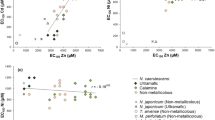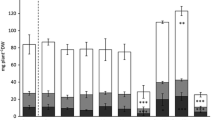Abstract
Cuprophytes are plants that mostly occur on Cu-rich soil in SC Africa. Crepidorhopalon perennis is endemic of a single site. C. tenuis has a broader niche, from normal to Cu-rich soil. Both have been considered as Cu-Co accumulators. We examined soil factors controlling heavy metal accumulation and plant fitness in natural populations. Plant mass and element concentrations in plants and soil were determined in 153 samples from five populations of C. tenuis on copper soil (CTC), two on normal soil (CTN) and the single population of C. perennis (CP). Soil in Cu-sites had higher concentrations of Ca, Mg, P, Mn, Zn, Cu, Co. Plants from Cu-sites were larger and had higher Cu and Co content, and lower Mg, Mn and Ca. Cu in shoots was influenced positively by Cu and Mn and negatively by Ca in the soil. Co in shoots was influenced positively by Co and negatively by Mn and Fe in the soil. Shoot mass was influenced positively by Cu and Mn (CT) or by Cu and Co (both species pooled) in the soil. The results suggest that C. tenuis and C. perennis are genuinely cuprophilous species. Large variation in metal accumulation in shoots can be accounted for by synergistic and antagonistic interactions among several heavy metals, yielding specific accumulation patterns in different populations.





Similar content being viewed by others
References
Antonovics J, Bradshaw AD, Turner RG (1971) Heavy metal tolerance in plants. Adv Ecol Res 7:1–85 doi:10.1016/S0065-2504(08)60202-0
Assunção AGL, Ten Bookum WM, Nelissen HJM, Vooijs R, Schat H, Ernst WHO (2003) Differential metal-specific tolerance and accumulation patterns among Thlaspi caerulescens populations originating from different soil types. New Phytol 159:411–419 doi:10.1046/j.1469-8137.2003.00819.x
Baker AJ, Brooks RR, Pease AJ, Malaisse F (1983) Studies on copper and cobalt tolerance in the three closely related taxa within the genus Silene L. (Caryophyllaceae) from Zaïre. Plant Soil 73:377–385 doi:10.1007/BF02184314
Baker AJM, Brooks RR (1989) Terrestrial higher plants which hyperaccumulate metallic elements: A review of their distribution, ecology and phytochemistry. Biorecovery 1:81–126
Bert V, Macnair MR, de Laguerie P, Saumitou-Laprade P, Petit D (2000) Zinc tolerance and accumulation in metallicolous and non-metallicolous populations of Arabidopsis halleri (Brassicaceae). New Phytol 146:225–233 doi:10.1046/j.1469-8137.2000.00634.x
Brady KU, Kruckeberg AR, Bradshaw HD Jr (2005) Evolutionary ecology of plant adaptation to serpentine soils. Annu Rev Ecol Evol Syst 36:243–266 doi:10.1146/annurev.ecolsys.35.021103.105730
Brej T (1998) Heavy metal tolerance in Agropyron repens (L.) P. Breuv. Populations from the Legnica copper smelter aera, Lower Silesia. Acta Societatis Botaniconum Pol 67:325–333
Brooks RR (1987) In: Dudley TR (ed) Serpentine and its vegetation. Dioscorides, Portland, OR, 454 pp
Brooks RR, Baker AJM, Malaisse F (1992) Copper flowers. Natl Geogr Res Explor 8:338–351
Brooks RR, Malaisse F (1985) The heavy metal-tolerant Flora of Southcentral Africa - a multidisciplinary approach. Balkema, Rotterdam, p 199
Brooks RR, Malaisse F (1990) Metal-enriched sites in South Central Africa. In: Shaw JA (ed) Heavy metal tolerance in plants: evolutionary aspects. vol. 18. CRC, New York, pp 53–73
Brooks RR, McCleave JA, Malaisse F (1977) Copper and cobalt in African species of Crotalaria L. Proc R Soc Lond 197:231–236
Brooks RR, Naidu S, Malaisse F, Lee J (1987) The elemental content of metallophytes from the Copper/Cobalt deposits of Central Africa. Bull Soc R Botanique Belg 119:179–191
Brooks RR, Reeves RD, Morrison RS, Malaisse F (1980) Hyperaccumulation of copper and cobalt — a review. Bull Soc R Botanique Belg 113:166–172
Cottenie A, Verloo M, Kiekens L, Velghe G, Camerlynck R (1982) Chemical analysis of plants and soils. Instituut tot Aanmoediging van het Wetenschappelijk Onderzoek in Nijverheid en Landbouw (I.W.O.N.L.), Brussels
Dechamps C, Roosens NH, Hotte C, Meerts P (2005) Growth and mineral element composition in two ecotypes of Thlaspi caerulescens on Cd contaminated soil. Plant Soil 273:327–335 doi:10.1007/s11104-005-0099-0
Duvigneaud P (1958) The vegetation of Katanga and its metalliferous soils. Bull Soc R Botanique Belg 90:127–286
Duvigneaud P, Denaeyer-De Smet S (1963) Cuivre et végétation au Katanga. Bull Soc R Botanique Belg 96:92–231
Ernst WHO (1974) Schwermetallvegetation der Erde. G. Fischer Verlag, Stuttgart
Ernst WHO (1990) Mine vegetation in Europe. In: Shaw JA (ed) Heavy metal tolerance in plants: evolutionary aspects. vol. 18. CRC, New York, pp 21–38
Ernst WHO (2006) Evolution of metal tolerance in higher plants. For Snow Landsc Res 80:251–274
Faucon MP, Shutcha M, Meerts P (2007) Revisiting copper and cobalt concentrations in supposed hyperaccumulators from SC Africa: influence of washing and metal concentrations in soil. Plant Soil 301:29–36 doi:10.1007/s11104-007-9405-3
Fischer E (1989) Contributions of the Flora of Central Africa III: new species of Lindernia Allioni and Crepidorhopalon E. Fischer (Scrophulariaceae) from Zaire, Burundi and Tanzania. Bull Jardin Botanique Natl Belg 59:445–457 doi:10.2307/3668359
Fischer E (1990) New species of Crepidorhopalon E. Fischer (Scrophulariaceae) from Zaire and Tanzania. Bull Jardin Botanique Natl Belg 60:409–413 doi:10.2307/3668231
Fischer E (1999) Scrophulariaceae (première partie). In: Bamps P (ed) Flore d’Afrique Centrale (Congo Kinshasa-Rwanda-Burundi):1–217
Hogan GD, Rauser WE (1979) Tolerance and toxicity of cobalt, copper, nickel and zinc in clones of Agrostis gigantea. New Phytol 83:665–670 doi:10.1111/j.1469-8137.1979.tb02298.x
Kabata-Pendias A, Pendias H (2001) Trace elements in soils and plants. CRC, LLC, Boca Raton, p 413
Ke W, Xiong ZT, Chen S, Chen J (2007) Effects of copper and mineral nutrition on growth, copper accumulation and mineral element uptake in two Rumex japonicus populations from a copper mine and an uncontaminated field sites. Environ Exp Bot 59:59–67 doi:10.1016/j.envexpbot.2005.10.007
Leteinturier B, Baker AJM, Malaisse F (1999) Early stages of natural revegetation of metalliferous mine workings in South Central Africa: a preliminary survey. Biotechnologie Agronomie Soc Environnement 3:28–41
Leteinturier B (2002) Evaluation du potentiel phytocénotique des gisements cuprifères d’Afrique centro-australe en vue de la phytoremédiation de sites pollués par l’activité minière. PhD. Thesis, Faculté des Sciences agronomiques de Gembloux, Belgium
Lou LQ, Shen ZG, Li XD (2004) The copper tolerance mechanisms of Elsholtzia haichowensis, a plant from copper-enriched soils. Environ Exp Bot 51:111–120 doi:10.1016/j.envexpbot.2003.08.002
Macnair MR (1983) The genetic control of copper tolerance in the yellow monkey flower. Mimulus guttatus. Heredity 50:283–293 doi:10.1038/hdy.1983.30
Macnair MR (2003) The hyperaccumulation of metals by plants. Adv Bot Res 40:63–105 doi:10.1016/S0065-2296(05)40002-6
Macnair MR, Gardner M (1999) The evolution of edaphic endemics. In: Howard DJ, Berlocher SH (eds) Endless forms: Species and speciation. Oxford University Press, Oxford, pp 157–171
Macnair MR, Macnair VE, Martin BE (1989) Adaptive speciation in Mimulus: an ecological comparison of Mimulus cupriphilus with its presumed progenitor, M. guttatus. New Phytol 112:269–279 doi:10.1111/j.1469-8137.1989.tb02383.x
Macnair MR, Smith SE, Cumbes QJ (1993) Heredity and distribution of variation in degree of copper tolerance in Mimulus guttatus at Copperopdis, California. Heredity 71:445–455
Malaisse F, Brooks RR (1982) Colonisation of modified metalliferous environments in Zaïre by the copper flower Haumaniastrum katangense. Plant Soil 64:289–293 doi:10.1007/BF02184264
Malaisse F, Grégoire J (1978) Contribution à la phytogéochimie de la Mine de l’Étoile (Shaba, Zaïre). Bull Soc R Botanique Belg 111:252–260
Malaisse F, Grégoire J, Morrison RS, Brooks RR, Reeves RD (1979) Copper and cobalt in vegetation of Fungurume, Shaba Province, Zaïre. Oikos 33:472–478 doi:10.2307/3544336
Morrison RS (1980) Aspects of the accumulation of Cobalt, Copper and Nickel by Plants, Ph.D. thesis. Massey University, Palmerston North, New Zealand
Morrison RS, Brooks RR, Reeves RD, Malaisse F (1979) Copper and Cobalt uptake by metallophytes from Zaïre. Plant Soil 53:535–539 doi:10.1007/BF02140724
Morrison RS, Brooks RR, Reeves RD, Malaisse F, Horowitz P, Aronson M, Merriam GR (1981) The diverse chemical forms of heavy metals in tissue extracts of some metallophytes from Shaba province, Zaïre. Phytochemistry 20:455–458 doi:10.1016/S0031-9422(00)84165-5
Paton A, Brooks RR (1996) A re-evaluation of Haumaniastrum species as geobotanical indicators of copper and cobalt. J Geochem Explor 56:37–45 doi:10.1016/0375-6742(95)00048-8
Proctor J, Woodell SRJ (1975) The ecology of serpentine soils. Adv Ecol Res 9:255–365 doi:10.1016/S0065-2504(08)60291-3
Reeves RD (2006) Hyperaccumulation of trace elements by plants. In: Morel JL, Echevarria G, Goncharova N (eds) Phytoremediation of metal-contaminated soils. NATO Science Series: IV: Earth and Environmental Sciences 68:1–25
Schat H, Ten Bookum WM (1992) Genetic control of copper tolerance in Silene vulgaris. Heredity 68:219–229 doi:10.1038/hdy.1992.35
Shaw AJ (1993) Population biology of the rare copper moss, Scopelophila cataractae. Am J Bot 80:1034–1041 doi:10.2307/2445751
Shaw AJ (1994) Adaptation to metals in widespread and endemic plants. Environ Health Perspect 102:105–108
Tadros TM (1957) Evidence of the presence of an edapho-biotic factor in the problem of serpentine tolerance. Ecology 38:14–23 doi:10.2307/1932121
Terry N, Bañuelos G (2000) Phytoremediation of contaminated soil and water. CRC, LLC, Boca Raton, p 387
Vlamis J, Jenny H (1948) Calcium deficiency in serpentine soils as revealed by absorbent technique. Science 107:549–551 doi:10.1126/science.107.2786.549
Weng G, Wu L, Wang Z, Luo Y, Christie P (2005) Copper uptake by four Elsholtzia ecotypes supplied with varying levels of copper in solution culture. Environ Int 31:880–884 doi:10.1016/j.envint.2005.05.032
Whiting SN, Reeves RD, Richards D, Johnson MS, Cooke JA, Malaisse F, Paton A, Smith JAC, Angle JS, Chaney RL, Ginocchio R, Jaffré T, Johns R, McIntyre T, Purvis OW, Salt DE, Schat H, Zhao FJ, Baker AJM (2004) Research priorities for conservation of metallophyte biodiversity and their potential for restoration and site remediation. Restor Ecol 12:106–116 doi:10.1111/j.1061-2971.2004.00367.x
Acknowledgements
The authors are grateful to François Malaisse for indicating locations of populations of Crepidorhopalon tenuis, to Wolf Gruber for mineral element analyses and Mylor Shutcha, Emile Kisimba, Bruno Mongoli and the staff of the Faculté d’Agronomie of the Université de Lubumbashi (Democratic Republic of Congo) for their invaluable assistance. Michel-Pierre Faucon is a research fellow of the FRIA. Financial support from the FNRS, the Université Libre de Bruxelles (Fonds Cambier) and the Coopération universitaire au Développement (CUD) is also gratefully acknowledged.
Author information
Authors and Affiliations
Corresponding author
Additional information
Responsible Editor: Henk Schat.
Rights and permissions
About this article
Cite this article
Faucon, MP., Colinet, G., Mahy, G. et al. Soil influence on Cu and Co uptake and plant size in the cuprophytes Crepidorhopalon perennis and C. tenuis (Scrophulariaceae) in SC Africa. Plant Soil 317, 201–212 (2009). https://doi.org/10.1007/s11104-008-9801-3
Received:
Accepted:
Published:
Issue Date:
DOI: https://doi.org/10.1007/s11104-008-9801-3




